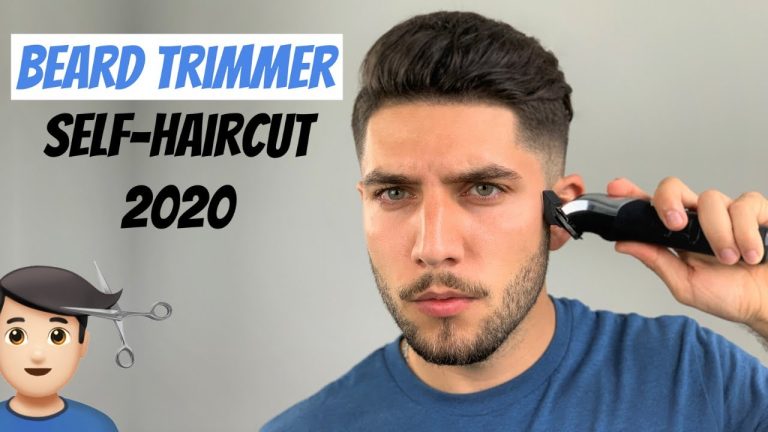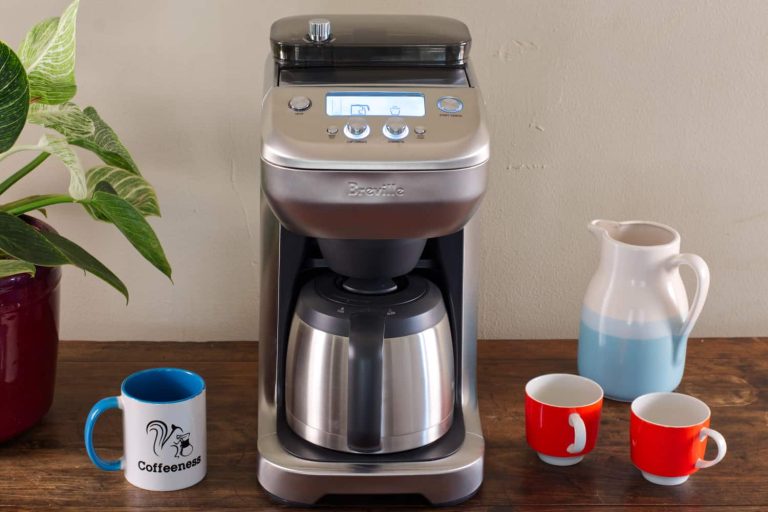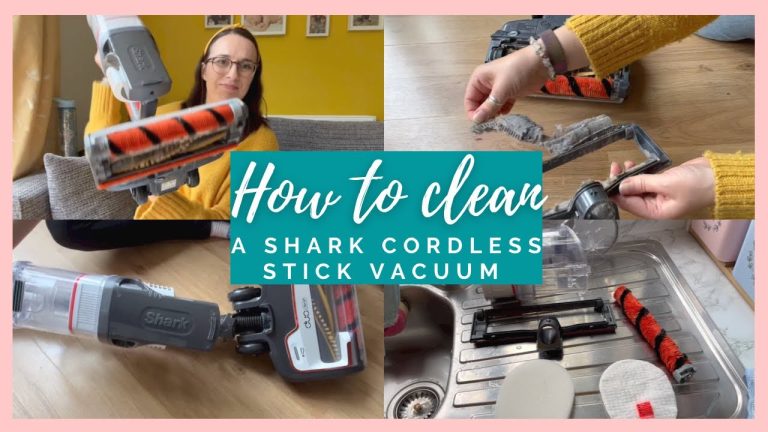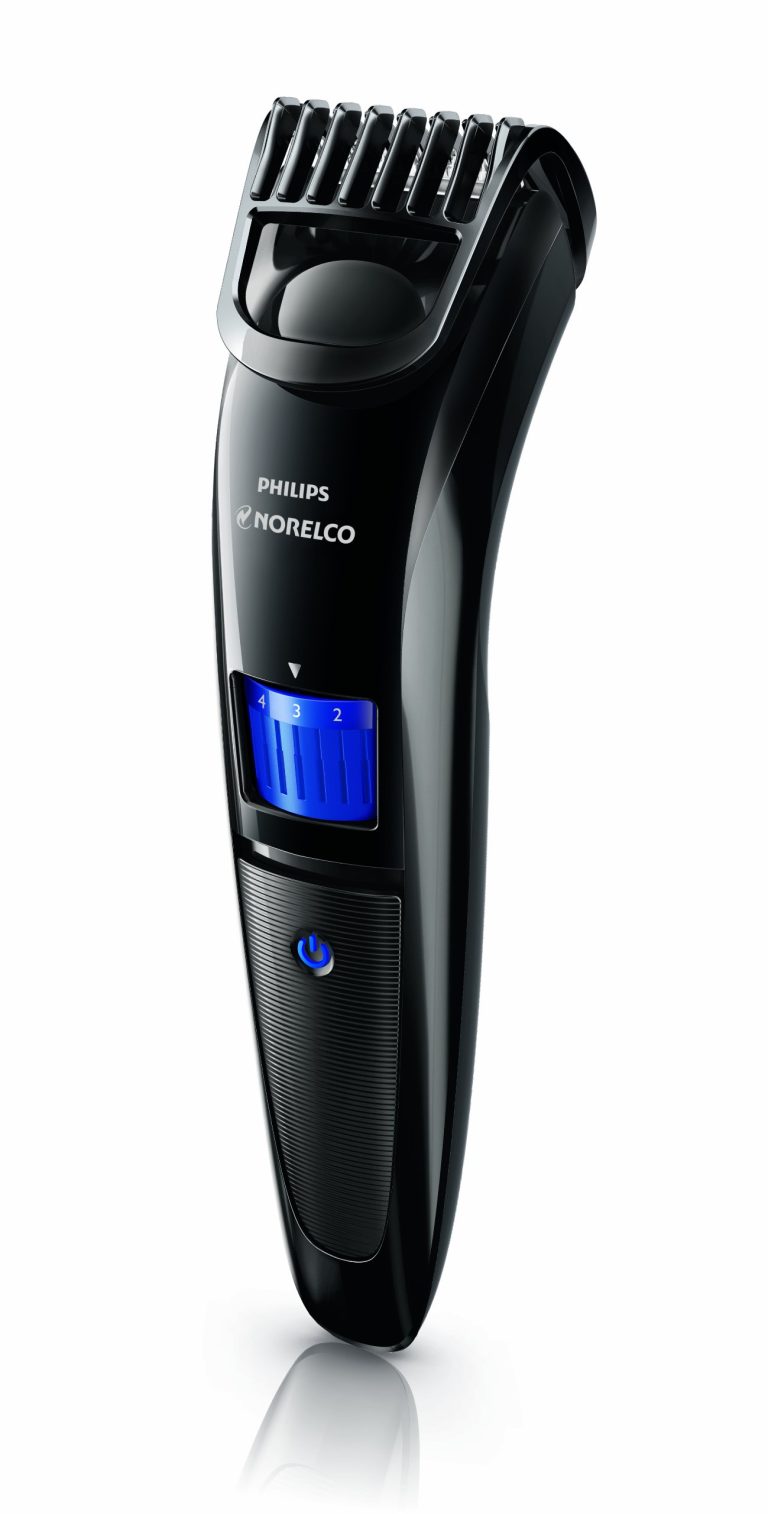How to Trim Beard With Beard Trimmer?
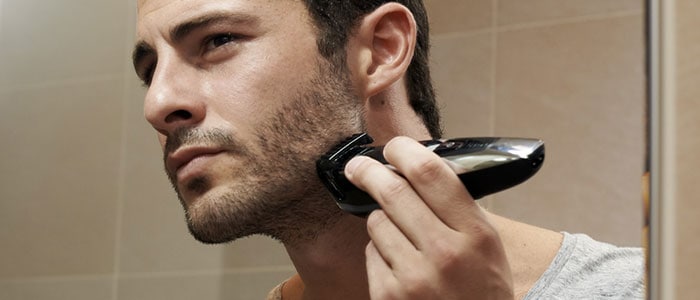
To trim your beard with a beard trimmer, start by choosing the desired length guard and trimming in the direction of hair growth, using short, controlled strokes. A well-groomed beard can greatly enhance a man’s appearance, giving him a stylish and polished look.
Maintaining a neat and well-trimmed beard requires regular maintenance and proper tools. One such tool is a beard trimmer, an essential grooming device that allows you to shape and style your facial hair as desired. We will guide you on how to effectively trim your beard using a beard trimmer, providing you with the necessary steps and tips to achieve a well-groomed and presentable beard look.
Understanding The Basics
When it comes to maintaining a well-groomed and stylish beard, trimming is an essential part of the process. Understanding how to trim your beard properly not only helps you achieve your desired look but also promotes healthy beard growth. Investing in a good-quality beard trimmer is a must for every bearded gentleman.
Why trimming your beard is essential
Trimming your beard regularly is essential for several reasons:
- Maintains a neat appearance: Trimming helps you keep your beard looking clean and well-maintained, preventing it from becoming unruly and unkempt.
- Controls length and shape: By trimming your beard, you have control over its length and overall shape. This allows you to create a style that suits your face and personal preferences.
- Promotes healthy beard growth: Trimming your beard regularly helps remove split ends and breakage, promoting healthier and stronger beard growth.
- Reduces itchiness and discomfort: Trimming can help eliminate the discomfort associated with longer, untrimmed beards, reducing itchiness and irritation.
Different types of beard trimmers available
When it comes to choosing a suitable beard trimmer, you’ll find a variety of options available in the market. Here are three common types:
- Electric beard trimmers: These trimmers are powered by electricity and are perfect for those who prefer convenience and precision. They often come with adjustable settings and different attachments for various trimming lengths.
- Battery-powered beard trimmers: Battery-powered trimmers are portable and great for traveling. They are lightweight and provide a reliable option for keeping your beard well-groomed on the go.
- Manual beard trimmers: Manual trimmers require no power source and are operated by hand. They are typically compact, versatile, and ideal for precise detailing and shaping.
The benefits of using a beard trimmer
Using a beard trimmer offers numerous benefits:
- Precision: Beard trimmers are designed for precise trimming, enabling you to shape and style your beard with accuracy.
- Time-saving: With a beard trimmer, you can achieve a well-groomed look quickly and efficiently, saving you time compared to using conventional scissors.
- Versatility: Beard trimmers often come with adjustable settings and various attachments, allowing you to experiment with different beard lengths and styles.
- Convenience: Investing in a good-quality beard trimmer means you can trim your beard at home whenever you want, without the need for frequent trips to the barbershop.
- Cost-effective: While the initial investment may be higher, a beard trimmer proves to be cost-effective in the long run, as it eliminates the recurring costs of professional beard grooming services.
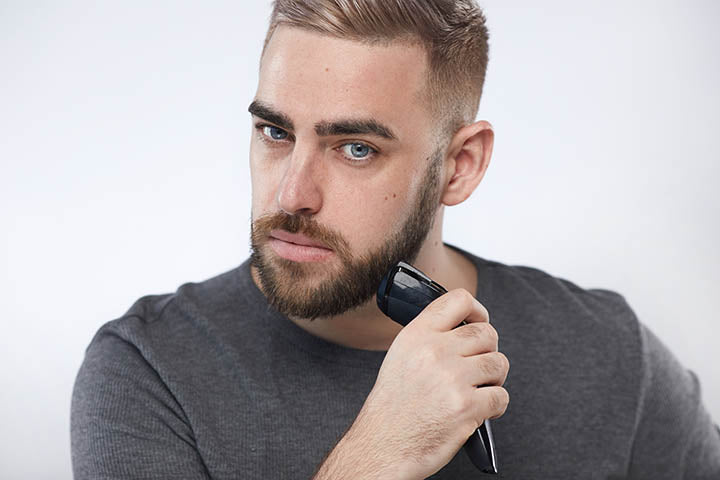
Credit: www.milkmanaustralia.com
Preparing For The Trim
Before you start trimming your beard with a beard trimmer, it’s important to properly prepare to ensure a successful trim. This involves cleaning and washing your beard, selecting the right beard trimmer for your needs, and choosing the ideal length for your trim. Follow these steps to make your trimming experience a breeze.
Cleaning and washing your beard
Before you pick up your beard trimmer, it’s crucial to clean and wash your beard. This not only removes any dirt or residue but also helps soften the hair, making it easier to trim. Follow these simple steps for a clean beard:
- Start by rinsing your beard thoroughly with warm water. This helps to remove any loose hairs or debris.
- Gently massage a beard-specific shampoo into your beard, ensuring it reaches the roots of the hair. This helps to remove any built-up oils or products.
- Rinse the shampoo out of your beard, again using warm water.
- Apply a conditioner specifically designed for beards. This helps to soften the hair, making it more manageable during the trim.
- Leave the conditioner in your beard for a few minutes, allowing it to deeply moisturize the hair.
- Rinse your beard again, ensuring all the conditioner is removed.
- Gently pat your beard dry with a towel, avoiding any vigorous rubbing that may cause damage or frizz.
Selecting the right beard trimmer for your needs
When it comes to selecting a beard trimmer, you want to choose one that suits your unique grooming needs. Here’s what you should consider when making your selection:
- Decide on the power source: Beard trimmers can be corded or cordless. Corded trimmers offer consistent power, while cordless trimmers provide more freedom of movement.
- Consider the length settings: Different trimmers offer various length settings, allowing you to achieve your desired beard length. Look for a trimmer with adjustable settings or a range that matches your preference.
- Check the blade quality: Opt for a trimmer with high-quality blades that are sharp and durable. This ensures a clean and precise trim without any tugging or pulling.
- Look for additional features: Some beard trimmers come with extra attachments or accessories, such as a precision trimmer or a nose hair trimmer. These can be useful for more versatile grooming.
Choosing the ideal length for your trim
Before you start trimming, it’s important to decide on the ideal length you want for your beard. This will depend on your personal style preference and the overall look you want to achieve. Here are some tips to help you choose the perfect length:
- Consider your face shape: Certain beard lengths complement different face shapes. For example, a shorter beard may accentuate a square face, while a longer beard can soften a more angular face.
- Experiment with different lengths: If you’re unsure about the ideal length, try experimenting with different settings or trim small sections of your beard at a time to see which length suits you best.
- Take maintenance into account: Shorter beard lengths require more frequent maintenance, while longer beard lengths may require less trimming but more attention to beard grooming and maintenance.
- Consult a professional: If you’re still unsure about the ideal length, consider consulting a professional barber who can guide you based on your unique facial features and style goals.
By following these steps and preparing adequately for your beard trim, you’ll be well on your way to achieving a perfectly groomed and neatly trimmed beard.
Step-By-Step Trimming Guide
When it comes to maintaining a well-groomed beard, knowing how to trim it with a beard trimmer is key. With the right technique and tools, you can achieve a polished and stylish look that suits your face shape and personal style. In this step-by-step trimming guide, we’ll walk you through the process of grooming your beard to perfection.
Trimming the neckline and defining the shape
Trimming the neckline is an essential step in maintaining a neat and tidy beard. To start, finding the right spot for your neckline is crucial. Place two fingers above your Adam’s apple and imagine a straight line extending horizontally across your neck. This will serve as a guide for trimming.
Using your beard trimmer with a suitable guard attachment, begin by gently removing any stray hairs below the neckline. Remember to trim in an upward motion to maintain a natural look. Gradually define the shape of your beard by trimming the areas around your jawline and cheeks. Take your time and assess the progress as you go.
Tapering the sideburns for a natural look
Tapering the sideburns is an important step to ensure a seamless transition between your beard and hair. To achieve a natural look, start by combing your sideburns downwards. Then, using a shorter guard on your trimmer, gently trim the edges of your sideburns, gradually blending them into your beard. This will create a well-groomed appearance and add definition to your facial structure.
Guiding the trimmer for even beard length
When it comes to achieving even beard length, it’s crucial to have a systematic approach. Begin by combing your beard in the direction of growth to detangle any knots or tangles. Using a longer guard on your trimmer, start trimming your beard from the bottom, moving upwards. Trim small sections of hair at a time, and make sure to maintain an even pressure as you guide the trimmer through your beard. This technique ensures that you achieve a consistent length throughout your beard.
Trimming the mustache and upper lip area
The mustache and upper lip area require special attention for a well-groomed look. To trim your mustache, comb it downwards using a fine-toothed mustache comb. Then, using a precise trimmer attachment or scissors, carefully trim any overgrown hairs that extend beyond your lip line. Take care to leave enough length to maintain a well-defined mustache shape that suits your face.
To ensure a clean and sharp look, pay attention to the area between your mustache and upper lip. Trim any stray hairs that may create an unkempt appearance. This will help refine your overall facial grooming and highlight your well-groomed beard.
By following this step-by-step trimming guide, you can effortlessly maintain a well-groomed beard that enhances your appearance. Remember to take your time, be patient, and pay attention to detail for the best results. Happy trimming!
Styling And Shaping Your Beard
When it comes to maintaining a well-groomed beard, one of the most important aspects is styling and shaping. This step helps create a polished and sophisticated look that enhances your facial features. By mastering the art of shaping your beard with a beard trimmer, you can achieve a stylish and well-defined look that suits your personality.
Creating symmetry and balance
To give your beard a professional finish, it is essential to create symmetry and balance. This means ensuring that both sides of your beard are equal in length and shape. To achieve this, start by combing your beard in the direction it naturally grows. This will unveil any unevenness or longer hairs that need trimming.
Using the precision of a beard trimmer, carefully trim the longer hairs to match the length of the shorter ones. Make sure to work in small sections, constantly checking for symmetry. Repeat this process on both sides, ensuring that your beard is evenly trimmed to create a harmonious and balanced look.
Using attachments and settings for various styles
One of the advantages of using a beard trimmer is the ability to change attachments and adjust settings to achieve different styles. Depending on the look you desire, you can experiment with various settings to achieve the perfect length for your beard.
For a shorter, stubble-like beard, use a shorter attachment or set your trimmer to a lower length setting. This will give you a neat and well-groomed appearance. Alternatively, if you prefer a longer beard, you can opt for a longer attachment or adjust the length setting accordingly.
| Style | Attachment/Setting |
|---|---|
| Stubble | Short attachment/low length setting |
| Moderate length | Medium attachment/medium length setting |
| Long beard | Long attachment/high length setting |
Achieving a sharp and crisp beard line
The key to a well-groomed beard is a sharp and crisp beard line. This helps define the shape of your beard and gives it a clean and polished look. To achieve this, follow these steps:
- Start by outlining the desired shape of your beard. Use a beard comb or another straight edge as a guide to ensure straight and sharp lines.
- Use the beard trimmer’s precision trimming blade or a smaller attachment to trim the hair along the edges of your beard. Work slowly and carefully, maintaining a steady hand to create sharp lines.
- For a more defined look, consider using a beard shaping tool or a razor to create an even sharper, smoother line along the edges of your beard.
Dealing With Common Beard Trimming Issues
While trimming your beard with a beard trimmer can be a quick and convenient way to maintain your facial hair, it’s not uncommon to encounter a few challenges along the way. Fortunately, there are solutions to some of the most common trimming issues that can help you achieve a well-groomed and healthy beard. In this article, we’ll address two key concerns when it comes to beard trimming: itchiness and ingrown hairs, as well as fixing mistakes and uneven spots.
Avoiding itchiness and ingrown hairs
Itchy beards and ingrown hairs can be not only irritating but also unsightly. To avoid these issues, it is important to follow a few essential steps in your beard trimming routine:
- Exfoliate: Before trimming your beard, take the time to exfoliate your skin. This removes dead skin cells and reduces the likelihood of ingrown hairs.
- Use a sharp and clean trimmer: Ensure that your beard trimmer is sharp and clean before each use. Dull blades can pull at the hair, leading to itchiness, while a dirty trimmer can introduce bacteria to your skin.
- Moisturize: After trimming, apply a beard oil or moisturizer to keep your skin and facial hair hydrated. This can help reduce itchiness and promote healthy beard growth.
Fixing mistakes and uneven spots
We’ve all been there – a slip of the hand or an uneven section during trimming. Thankfully, there are a few tricks you can employ to fix mistakes and even out the look of your beard:
- Go slow: When adjusting an uneven spot, take your time. Trim small sections at a time and compare with the rest of your beard to ensure a more gradual and natural transition.
- Blend with scissors: If you’ve trimmed too much in a specific area, using a pair of scissors can help blend and soften the edges for a more seamless look.
- Consider a different style: If you’re finding it difficult to fix a mistake or uneven spot, don’t be afraid to embrace a new beard style. Sometimes, a different shape or length can help create a fresh look while minimizing the appearance of errors.
By following these tips, you can navigate common beard trimming issues with ease and maintain a healthy and well-groomed beard. Remember to be patient and take your time, as mastering the art of beard trimming requires practice. With a little effort and attention to detail, your beard will be looking sharp and stylish in no time!
Aftercare And Maintenance
Once you’ve achieved the perfect trim with your beard trimmer, it’s important to take care of your beard and the trimmer itself. Proper aftercare and maintenance will not only keep your beard looking its best but also prolong the lifespan of your trimmer, ensuring you get the most out of your grooming investment. In this section, we will discuss cleansing and moisturizing your trimmed beard, the trimming frequency for different beard lengths, and how to properly store and maintain your beard trimmer.
Cleansing and moisturizing your trimmed beard
After you have trimmed your beard, it’s essential to cleanse and moisturize to keep it healthy and well-groomed. Here are a few simple steps to follow:
- Cleanse: Use a beard shampoo or mild soap to gently cleanse your beard. Massage the cleanser into your beard and rinse thoroughly with warm water. Pat your beard dry with a towel.
- Moisturize: Apply a beard oil or balm to moisturize and condition your beard. This will help keep your beard soft, manageable, and free from dryness or itchiness. Massage the oil or balm into your beard, making sure to distribute it evenly from roots to ends.
- Style: If desired, use a beard brush or comb to style your trimmed beard. This will help keep your beard looking neat and tidy throughout the day.
Trimming frequency for different beard lengths
The frequency at which you trim your beard will depend on its length and your personal preference. Here are general guidelines for different beard lengths:
| Beard Length | Trimming Frequency |
|---|---|
| Stubble | Trim every 2-3 days to maintain a short, groomed appearance |
| Short beard | Trim every 1-2 weeks to maintain shape and remove split ends |
| Medium beard | Trim every 2-4 weeks to control length and maintain a well-groomed look |
| Long beard | Trim every 4-6 weeks to shape, remove split ends, and ensure healthy growth |
Properly storing and maintaining your beard trimmer
Keeping your beard trimmer in good condition is crucial for optimal performance and longevity. Follow these tips for storing and maintaining your beard trimmer:
- Clean after each use: After each trim, detach the blade head and brush away any loose hair. Use a small brush to remove hair from the blade area. Wipe the trimmer gently with a clean cloth to remove any debris.
- Oil the blades: Regularly apply a few drops of clipper oil to the blades to keep them lubricated and prevent rusting.
- Store in a dry place: Keep your trimmer in a dry area to avoid moisture damage.
- Replace dull blades: If you notice the trimmer is not cutting as effectively, it may be time to replace the blades.
By following these aftercare and maintenance tips, you can enjoy a well-groomed beard and a long-lasting beard trimmer that continues to deliver excellent results.
Tips And Tricks For A Professionally Trimmed Beard
Tips and Tricks for a Professionally Trimmed Beard
Having a well-groomed beard is not only stylish but also helps to exude confidence and enhance your overall appearance. When it comes to trimming your beard, using a beard trimmer is essential to achieve a professional and polished look. In this article, we will share some valuable tips and tricks that will help you master the art of trimming your beard with a beard trimmer.
One of the best things about having a beard is the ability to experiment with various styles and looks. With a beard trimmer, you have the freedom to shape and contour your facial hair to achieve the desired style. Whether you prefer a full beard, a goatee, or a well-trimmed stubble, the key is to know your facial features and choose a style that complements your face shape.
If you’re unsure about which style would suit you best, consider consulting with a professional barber or stylist. They can provide expert advice on what styles would work well with your facial structure and hair type. Remember, it’s important to choose a style that reflects your personality and makes you feel confident and comfortable.
No beard grooming routine is complete without the use of high-quality grooming products. These products not only help maintain the health and appearance of your beard but also make the trimming process smoother and more effective. Here are some essential beard grooming products you should consider incorporating into your routine:
- Beard oil: Apply a few drops of beard oil to your beard and skin to moisturize and soften the facial hair. This will make the trimming process easier and reduce any irritation or itching.
- Beard balm: Beard balm helps tame unruly hairs and provides a light hold. It also adds shine to your beard, giving it a healthy and groomed look.
- Beard comb/brush: Use a beard comb or brush to detangle and style your beard. This will ensure an even trim and help distribute the grooming products evenly throughout your facial hair.
In some cases, seeking professional help or advice can make a significant difference in achieving a professionally trimmed beard. Trained barbers or stylists have the expertise and experience to create intricate styles and handle more complex trimming techniques. They can provide valuable insights into beard maintenance, grooming routines, and recommend products that cater to your specific needs and preferences.
If you’re uncertain about your trimming skills or want to try a new style, consider visiting a barber for a professional trim. This not only ensures excellent results but also gives you the opportunity to learn from the experts and gather useful tips and tricks.
Maintaining a well-groomed beard requires consistency and proper care. By experimenting with different styles, incorporating beard grooming products into your routine, and seeking professional advice, you’ll be on your way to achieving a professionally trimmed beard that turns heads wherever you go.
Frequently Asked Questions Of How To Trim Beard With Beard Trimmer
How Do You Trim A Beard With A Trimmer For Beginners?
To trim a beard with a trimmer as a beginner, start by selecting the desired length setting on the trimmer. Trim in the direction of hair growth, using even and gentle strokes. Pay attention to the neckline and cheekline for a neat appearance.
Do You Trim Up Or Down With A Beard Trimmer?
To trim a beard, you use a beard trimmer. It helps you maintain the desired length by trimming it evenly.
What Is The Correct Way To Hold A Beard Trimmer?
To hold a beard trimmer correctly, grip it firmly but not too tightly. Place your thumb on the power button and your fingers around the handle for optimal control. Keep the trimmer at a 90-degree angle and use smooth, downward strokes for even trimming.
How Close Does A Beard Trimmer Cut?
A beard trimmer can cut your beard very close, leaving a short, precise trim. Its blades are designed to trim hair as close as 0. 2mm, giving you a neat and well-groomed look.
Conclusion
Mastering the art of trimming your beard with a beard trimmer is essential for maintaining a well-groomed appearance. By following the steps mentioned in this blog post, you can easily achieve the desired beard length and style. Remember to choose the right trimmer, set the appropriate length, trim in the direction of hair growth, and take your time to avoid any mishaps.

